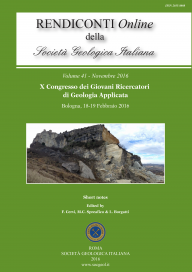
Implementing the Boolean Stochastic Generation method on a 3D model of two convergent landslides
Giulia Bossi (a) & Gianluca Marcato (a)
(a) CNR-IRPI – National Research Council of Italy Research Institute for Geo-HydrologicalProtection Padua Italy. E-mail: giulia.bossi@irpi.cnr.it
Volume: 41/2016
Pages: 119-122
Abstract
The Boolean Stochastic Generation (BoSG) method allows to generate randomly, inside an uniform soil matrix, lenses with different soil properties. In this work the algorithm to implement a BoSG simulation on a 3D model of an actual case-study is presented.
In the Carnian Alps, in the Tagliamento River valley (46°23'49" N, 12°42'51" E), two adjacent landslide affect the National Road 52 "Carnica". The phenomena have been studied for more than a decade allowing a detailed geological and geomorphological reconstruction to be delineated. That was done on the ground of a large number of monitoring data collected during more than 10 years of investigations. Moreover, an helicopter-borne Light Detection And Ranging (LiDAR) survey provided a 1 m Digital Terrain Model (DTM) of the area's topography.
A 3D reconstruction of the slip surfaces of the landslide was created based on inclinometric data and geomorphological evidence.
A specific Matlab program allowed to reconstruct the geometry of the landslide in FLAC, inserting the topography and the slip surface. The disposition of the material was randomized in one of the landslide in order to evaluate the effect of minor stratigraphic variation on the deformation pattern of the models.
Results show that the variation of maximum displacement between different soil configurations is significant and that the BoSG method is an useful tool to evaluate the uncertainty associated with the soil distribution pattern inside a landslide body.
Keywords
Get Full Text